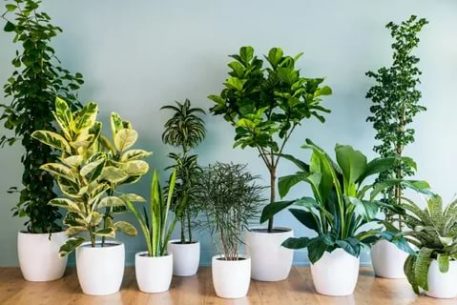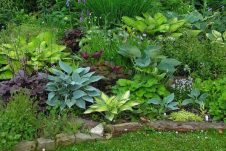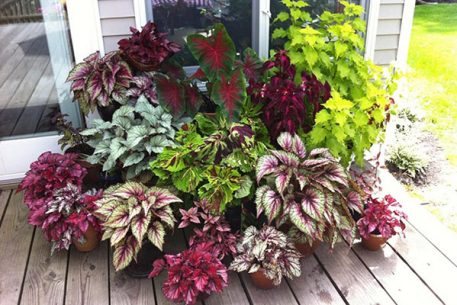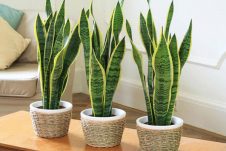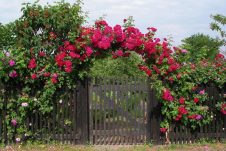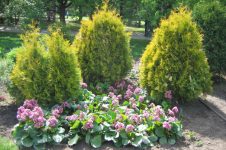Dressing is a decoration of an interior, an improvement of a garden, a country site or the room. Ornamental plants have long been used for this purpose. They will give a certain flavor to the environment, with their help you can create comfort in the apartment or organize a unique design of the garden plot.
Material Content:
What plants are called decorative
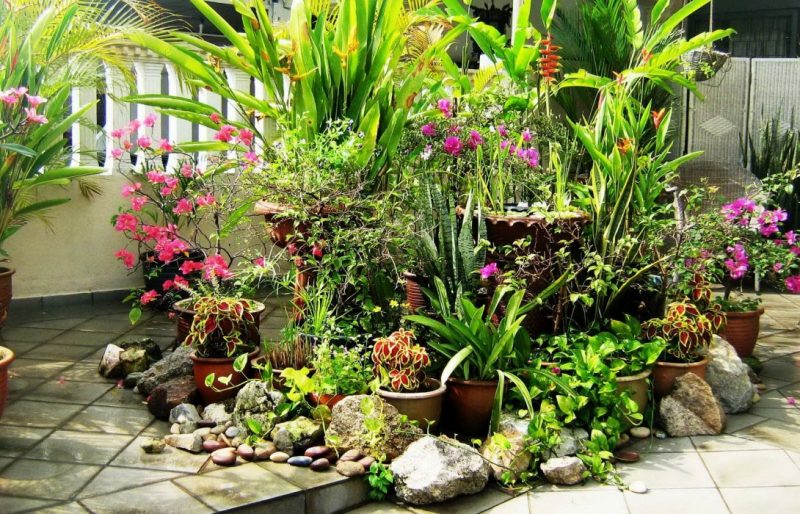
Ornamental plants fulfill the main task of design - to decorate. Their varieties and species depend on this. Allocate garden, indoor flowers and shrubs. All of them are cultivated plants.
Coniferous and deciduous trees and shrubs are grown in the gardens. There are curly species. Some of them have decorative foliage. They may have small inconspicuous flowers, but the leaves have a beautiful color or colored stripes.
Curly decorative creepers can be strewn with flowers, like climbing roses and clematis, and can decorate fences and walls of buildings with leaves of unusual colors, like Amur or girl's grapes.
Classification of ornamental plants
They can be classified according to various criteria. Main characteristics:
1. Growing conditions - a flower bed, garden or apartment.
2. The required lighting - photophilous, shade-tolerant, partial shade-tolerant.
3. The growing season - annuals, biennials, perennials.
4. Type of decoration - tree, shrub or flowers.
5. Achievable sizes - tall, medium and stunted.
When decorating a garden plot, it is important to decide which species to prefer. Annual and perennial flowers require a different approach to growing. Let us consider in more detail the characteristics of each of these species.
Perennial
Ornamental plants for the garden include trees, shrubs, perennial grassy species. They achieve full decorativeness gradually, but then delight with their beauty, no longer requiring effort.
When planting crops, we leave the distance necessary for their further development, without thickening the planting.
Biennial and annual
Annual plants live one season. Most often they are cultivated by pre-growing seedlings. The seeds of some of them are planted in February, such as, for example, a petunia to get a flowering plant. Not all annuals without seedlings can bloom, they usually do not have enough for this warm time.
Popular garden annuals include such flowers:
- petunia
- aster;
- lobelia;
- ageratum;
- Snapdragon;
- gypsophila;
- marigold;
- elegant zinnia;
- salvia.
Of the curly popular:
- sweet pea;
- morning glory;
- nasturtium;
- colored beans.
Read also: planting and caring for nasturtium
Biennials can be attributed to perennials with a short growing season. In the first year, these flowers form a rosette of leaves that survives winter. The next year, flowering begins. By the fall, they die. These plants are very hardy. They are sown in early spring on a seedling bed, in August they are transplanted to a permanent place. They should take root in the cold.
Biennial colors include:
• Turkish carnation;
• viola;
• violet;
• bell;
• daisy.
Tall biennial - digitalis. A very spectacular plant, strewn with bells, like thimbles. Seeds are sown in early June. It is important not to allow the soil to dry out, otherwise you will not receive seedlings. Digitalis is best propagated by separating rosettes from an adult plant.
Another tall plant is mallow (mallow, stock-rose). She has large seeds that are buried during planting. They are planted in May in the ground. The next season it will bloom the entire warm period.
Decorative flowering house plants

Ornamental plants play a very important role in decorating indoor spaces. In addition to the benefits of absorbing carbon dioxide and purifying the air, increasing the humidity in the room, they delight the eye with their colors, revitalize the room, especially in winter and autumn.
Decorative-flowering varieties adorn the interior with bright colors. For them, it is necessary to create conditions suitable for humidity and lighting.
Photophilous
1. One of the representatives of flowering plants who love sunny places is hibiscus. This large tree-like bush blooms constantly, but each flower lives for one day. Large glossy leaves are also beautiful.
2. Very beautiful balsam. It is characterized by long flowering with bright roses, which are strewn with bush. Flowers have a variety of colors.
3. Ampelic room lobelia will decorate balconies and loggias, it is good in flowerpots on a wall or window. Color is white or blue.
4. Uzambara violet grows on almost every windowsill. Unpretentious. Easily propagated, for this you can use the leaves of the flower. Compact plant, blooms with flowers of various shapes and colors.
5. Orchid phalaenopsis - a flower of unusual shape. From a lush rosette of leaves a peduncle is thrown, strewn with flowers of bright color. Airy green roots emerge from the pot and also adorn the plant. It does not require unnecessary attention, the main thing is to occasionally put the pot in water for half an hour, and spray for lush flowering. He loves light shading, grows well on eastern loggias and window sills.
Shady
1. Spathiphyllum tolerates a lack of light. This flower is decorated with a white delicate petal with a yellow bump in the center. It does not require special care. He needs to arrange a rest period in the winter.
2.Clivia has long saber-like leaves and a bright bunch of flowers in the center of the bush. It can grow in a dark hallway with artificial lighting. Blooms in February.
3. Delicate white calla has the shape of a shell with a yellow bump inside. It blooms from November to May. All winter will delight in bloom, easily tolerates the climate in the apartment. It requires a period of rest.
Decorative foliage indoor plants
These are plants whose main decoration is leaves. They have an unusual shape and color, are variegated or striped. Among them, one can distinguish curly vines and upright species.
Wicker
Among decorative leafy wicker forms are represented by a wide range.
1. Scindapsus. Subtropical species of the aroid family. Has green leaves with grayish stains. Shade-tolerant, does not like bright sunlight, requires a constant temperature. Watering is moderate and humidity is high. It is necessary to spray the leaves. He does not need frequent transplants, he builds up the root system slowly.
2. Syngonium. This is also a subtropical liana. The leaves are located on long stalks, there are green shades, or there are strips along the veins. Transplanted every two to three years in a flat pot with good drainage. Propagated by cuttings.
Direct growing
1. Ficus Benjamin. Favorite indoor flower florists. With it, you can create interesting compositions. You can form a bonsai-style tree, grow a lush bush, plant two seedlings in a pot and twist the trunks, getting an unusual tree. The leaves of this ficus are green or variegated. Prefers ambient light. Variegated species require brighter lighting. It grows well at ordinary room temperature, it needs a rare but plentiful watering. It requires frequent transplantation, as it is growing rapidly. Propagated by green cuttings.
2. Laurel noble. The sacred plant of the Greeks. It is difficult to grow on the windowsill, it requires a cool temperature in winter, which is poorly feasible in urban apartments. It has bright green elongated leaves. It releases volatile, used as spices. It can grow a large tree, if there is enough for this place. Care is carried out, as well as for ficus.
Homemade Succulents

1. Crassula (fat woman). It is also called the money tree. It has thick fleshy leaves. If you pinch the shoots, you can form a beautiful tree. Absolutely unpretentious. He loves bright lighting, grows well on the south window. In winter it is placed in a cool place. Water rarely, but plentifully. Do not allow stagnation of water in the pot. For propagation, apical cuttings or leaflets are used.
2. Zamioculcas or dollar tree. It does not require bright lighting. The rest of the care, like all succulents. The flower has no shoots. Unusual complex leaves consisting of leathery fleshy plates grow from the roots. They are taken for individual leaves. It grows well in breadth and up.
Garden Ornamental Plants
Ornamental plants of the garden include trees, shrubs, perennial and annual flowers. Each of them has its own special place in the garden and serves as its decoration.
Trees
Among ornamental trees, conifers occupy the first place in popularity. Having reached adulthood, they require a minimum of care, do not require watering and fertilizers, and remain decorative at all times of the year. In the spring, some conifers bloom with beautiful candles, and shoots are updated.
Among coniferous trees in the garden, spruce, pine, thuja are especially common. Spruce grows well on wetlands, which is very important for many garden plots. The pine is drought-resistant, well formed by pruning, you can create a tree of the desired height and shape.
Thuja come in pyramidal, ellipsoidal or spherical shape. They are planted to form a decorative wall. Spherical thuja will fit into any garden composition.
Among the deciduous ornamental trees, the most popular are a variety of maples, magnolia, sakura, fruit trees.
Canadian, plane-tree, holly maples are popular. They have leaves of an unusual color; the birch leaves adorn the holly appearance. They are beautiful on an open lawn, along the fence and on the background of a green hedge. They require a sunny place to achieve maximum decorativeness.
Among the apple trees, decorative species are known that bloom profusely with rich pink flowers. After flowering, they are strewn with small fruits of yellow, pink or red color. They serve as decoration of the garden until late autumn.
Among the exotic species, magnolia and sakura are grown. They are not as whimsical as they seem. Deciduous magnolia grows beautifully in our gardens. For her, you need to choose a sunny place, protected from cold winds and drafts. The soil should be acidified. An adult tree only requires trimming old and damaged branches. For winter, only young plantings shelter.
Japanese cherry sakura is able to grow in the middle regions of Russia. She will need a protected sunny place. The soil must be liming. The tree needs abundant watering and protection from harmful insects.
Shrubs
Ornamental shrubs are represented by various types of juniper, microbiota, barberry, hydrangea, lilac, viburnum, henomeles or Japanese quince, roses and others.
Cossack juniper - a groundcover evergreen, grows widely, when planting requires compliance with the distance of one and a half meters between the bushes. It prefers light soils, blends beautifully with variegated shrubs, looks good on the lawn. It requires a minimum of care.
Barberries have multi-colored leaves. They are green, purple, red. In some varieties, the leaves turn red with the onset of autumn. The hedge of their barberry looks beautiful. Small flowers turn into red berries, which serve as a seasoning for various dishes.
Thunberg's barberry goes well with coniferous shrubs. Barberry Green Carpet, similar to a green pillow, is used for the Japanese rocky garden.
Japanese quince in early spring is covered with small orange flowers, yellow hard fruits adorn the bush until late autumn. They are rich in vitamins, used for cooking preserves and compotes.
Garden hydrangeas adorn the garden with lush bouquets. Even faded inflorescences retain their decorative effect. They love acid soil and plenty of moisture. Do not tolerate stagnation of moisture at the roots.
The queen of flowering shrubs is the rose. It has a wide variety of species, shapes and colors. Floribunda, park roses, climbing creepers. It is difficult to describe all the diverse species of this unique flower.
Climbing plants
1. Actinidia. Powerful vine that requires strong support. It has beautiful variegated leaves, in spring it blooms with pink flowers with a delicate aroma. This is a fruit crop, for the harvest, it is necessary to plant male and female individuals. The taste of actinidia berries resembles kiwi. The culture is frost-resistant.
It is interesting:actinidia
2. Clematis. Liana clings to the supports with leaves. The plant is rather capricious, requires proper planting and the choice of a sunny place. In different varieties, flowering is carried out on the shoots of the past and present year. Depending on this, the shoots are trimmed. With proper care, it will please with abundant flowering. It requires shelter for the winter.
3. A climbing rose can be considered the most beautiful representative of this genus of flowers. Lush flowering continues from early June to late October. It requires care, in spring it is necessary to prune dead branches. For prolonged flowering, wilted flowers should be removed. It is necessary to shelter from winter frosts.
4. Honeysuckle grows well on clay and sandy soils. Strongly grows over the summer, blooms in small flowers of various colors with a delicate smell.Every fall, it is necessary to cut off dry, lying on the ground and thickening shoots. In winter, the plant is removed from its support and covered.
Flowering plants for the garden
Flowering plants in the garden are distinguished by the timing of flowering. Crocuses are one of the first to bloom. Their colorful caps appear almost from under the snow. They bloom from March to May. Love a sunny place and light soil. Planted with bulbs from August to September.
Queens of the spring flower beds are undoubtedly tulips. The variety of shapes and colors of these colors is amazing. Early varieties bloom in April, then flowering continues in May. The latest tulips bloom in June.
After the shoots wither, the bulbs are dug up and stored in a cool, dry place. Planted in flower beds in September.
Try not to be late with the digging of tulips, otherwise you simply will not find them in the ground.
In May, it is time for perennials to bloom. Of the early species can be called Brunner. Among the large gray-green leaves appear tender blue bunches of flowers. This flower remains decorative all summer, thanks to colorful leaves.
At the end of May, aquilegia flourishes. It is also called the catchment, for the ability of the flowers to retain moisture after rain. This perennial prefers shady corners. Not only flowers are decorative, but also leaves.
Astilba. This perennial has many varieties blooming from June to September. Carved leaves are already decoration, and when it blooms with magnificent panicles, it attracts attention with its beauty. The plant is shade-loving. There are heights from 40 to 120 cm, depending on the variety.
Closer to autumn, phloxes bloom. Phlox paniculata is a very colorful tall plant. Inflorescences are collected in dense bouquets, exude a strong aroma. Not a demanding culture. With a minimum of care, you can get a beautiful flower.
And of course, the queens of autumn are chrysanthemums. Starting from low october with small flowers, and ending with large varieties with lush flowers. They bloom to frost. After that, the bushes are cut. For winter, you can cover with dry foliage or grass.
Decorating the surrounding area with the help of plants has always attracted people. To give the room a residential appearance, enrich it with flowers and green foliage, indoor plants are used. In the garden, you can use a rich arsenal of flowers and ornamental plants to make life more enjoyable, to surround yourself with beauty.


